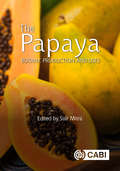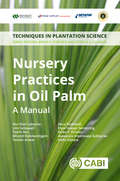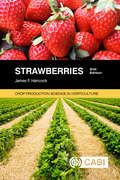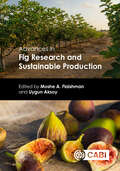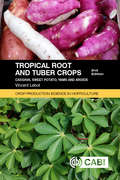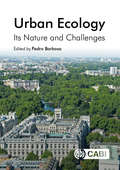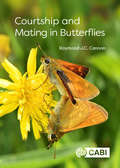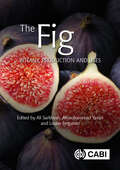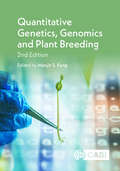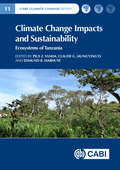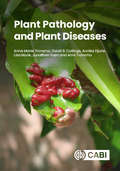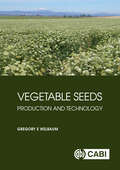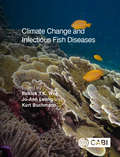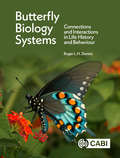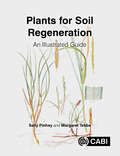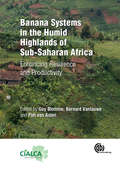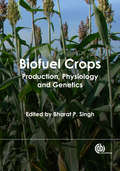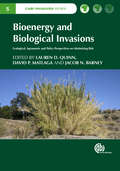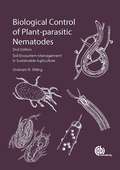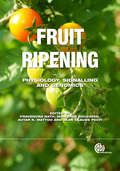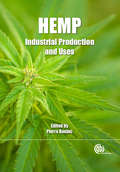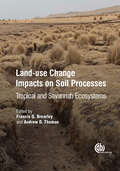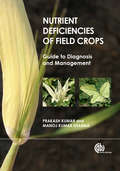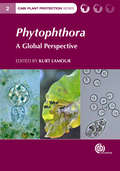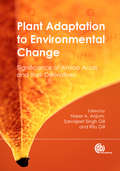- Table View
- List View
The Papaya: Botany, Production and Uses (Botany, Production and Uses)
by Amalendu Ghosh Robert E Paull Víctor Galán Saúco Edward Evans Rebecca Ford S H Ahmad Christian Alcocer Fredy H Ballen Luis Barboza-Barquero Paul R Campbell A Chan Fure-Chyi Chen Nancy Jung Chen Ting-Chi Cheng Shih Wen Chin Rod Drew Franscisco Espadas Humberto Estrella João Paulo Fabi Gabriela Fuentes Amaranta Giron Julián Cuevas González Eric Guevara Marco V Gutiérrez-Soto Eudaldo Pérez Hernández Jian-Zhi Huang Víctor M Jiménez Chutchamas Kanchana-Udomkan Matiyar Rahaman Khan Chen-Yu Lee Wen-Li Lee Pauziah Muda M Munirah Usana Nantawan Eder Dutra Resende Jorge Manuel Santamaria-Fernandez S K Sharma N I Shukor N E Tajidin Carlos Talavera Lynton L Vawdrey Ziwei ZhouPapaya (Carica papaya) is an important and widely-cultivated tropical fruit, grown in more than 60 countries of the world. Global papaya production has grown significantly over the last few years, mainly as a result of increased production in India. Papaya has become an important agricultural export for developing countries where export revenues of the fruit provide a livelihood for thousands of people, especially in Asia and Latin America. This book includes coverage of recent research developments with the potential to improve crop yields and quality. New research has contributed to our understanding of the crop environment, plant growth and physiology of tree and fruit development with implications for both breeding and cultivation. It looks at how analysis of the papaya genome promises new, faster breeding techniques to improved cultivars and how these and other advances are helping to tackle disease like papaya ring spot viruses and major pests which cause significant losses. Key features include: updated information for sustainable papaya cultivation research developments in tackling the major production and post-harvest problems interdisciplinary and collaborative research With contributions from international experts, the book presents the current state of knowledge concerning the history, physiology, culture and marketing of papaya throughout the world. It is an essential resource for researchers, growers and all those involved in the papaya industry.
Nursery Practices in Oil Palm: A Manual (Techniques In Plantation Science Ser. #17)
by Brian Forster Umi Setiawati Fazrin Nur Miranti Rahmaningsih Yassier Anwar Nur D Laksono Heru Rusfiandi Eben Haeser Sembiring Avasarala Sreenivasa Subbarao Hafni ZaharaThis is a hands-on, practical guide to general and specific practices in oil palm nurseries to produce healthy, vigorous and uniform plants ready for field planting. There are two nursery stages, pre-nursery and main nursery. The pre-nursery receives both germinated seeds and tissue culture produced plantlets (ramets) which are planted in a relatively small area in which shade and humidity can be controlled. Once young plants are established they are transferred to the main nursery, potted-on and grown on to produce field-ready plants. Good nursery practices, using sustainable approaches where possible, aim to provide high quality planting materials for both commercial production and field trialling. The book covers: Nursery set up - pre-nursery and main nursery Fertilizer programmes Watering Culling Weeding Pests and diseases Pre-field genotypic screening and selection Quarantine nurseries This is an invaluable manual for commercial seed producers, nursery plant producers, commercial plantation companies and plant breeders, as well as researchers in oil palm. It is useful for those starting a career in oil palm production, and as a reference guide for managers and for training purposes.
Strawberries (Crop Production Science in Horticulture)
by James HancockThis new and updated edition of a popular text provides a broad, balanced review of the scientific knowledge of strawberries and their cultivation. The worldwide strawberry industry has grown substantially since the original book was published, and methods of culture have undergone extensive modifications. This volume incorporates important changes to the taxonomy of strawberries and new understanding of how its ancestors evolved. It includes coverage of new disease and pest control methods and recent developments in genomic information. These advancements have greatly improved our understanding of how flowering and fruiting is regulated, and will revolutionize the breeding of strawberries. Drawing on extensive research and practical experience, the author presents an essential text that: Includes new content on genomic data, trait genetics, and marker-assisted strategies for varietal improvement. Provides a thorough review of the evolution of the strawberry and the history of strawberry cultivation. Contains an up-to-date comparison of the cultural systems employed across the world and the physiology behind these practices. Presented in full-colour throughout, this is a core guide for academic and professional researchers, breeders and growers, advisors, extension personnel and students of horticulture.
Advances in Fig Research and Sustainable Production
by Arpan Modi Belit Balci Avital Bechar David Ben-Yakir H Zafer Can Yafit Cohen Alain Costa Dan Eisikowitch Toufic Elbeaino Mahua Ghara Ali Muhammet Gündesli Hidetoshi Ikegami Burhanettin Imrak Esref M Irget Ebru N. Kafkas Salih Kafkas Kumar Lama Simcha Lev-Yadun Margarita López Corrales Huiqin Ma Alberto Martin Kamil M. Meriç Dvora Namdar Betül K. Özer Reut Peer Antonio Piga Victor Rodov Manuel Joaquín Serradilla Sánchez Kenta Shirasawa Fatih Sen Ece Tirkaz Eleni Tsantili Ferit Turanli Christian Ponce Vera Yanlei Zhai Irit Ziffer Daniel ValeroThe common fig (Ficus carica L.) is one of the oldest fruits domesticated by humans, and is native to southwest Asia and the Mediterranean. Figs have been associated with health and prosperity since ancient times. They are rich in fibre, potassium, calcium, and iron, as well as being an important source of vitamins, amino acids, and antioxidants. In recent years, increased consumption has caused fig production to shift to new countries such as Mexico, Brazil, India, and China. However, fig is a challenging fruit crop to grow. It is susceptible to insect pests and diseases as well as injuries from abiotic stress during fruit development and ripening. As a delicate fruit it also requires complicated postharvest procedures and climate change presents additional challenges. Comprising 29 chapters written by international experts, the book includes sections on: History Biology and Orchard Management Fruit Ripening and Postharvest Management Pests and Diseases Omics Analysis Cultivars and Breeding Products and Trade. This volume serves as a comprehensive reference for current and future practices of fig production, consumption, research and innovation, and is essential for academic researchers, and those involved in research and development in the fig industry.
Tropical Root and Tuber Crops: Cassava, sweet potato, yams and aroids (Crop Production Science in Horticulture #No. 17)
by Vincent LebotRoot and tuber crops are important to agriculture, food security and income for 2.2 billion people in developing countries. These species produce large quantities of dietary energy and have stable yields under difficult environmental conditions. This second edition of Tropical Root and Tuber Crops is an authoritative treatment of four important root and tuber crops: cassava. sweet potato, yams, and aroids. The same format is followed for each crop: Origin and History, Taxonomy and Botany, Breeding and Genetics, Developmental Physiology, Agronomy, Pests and Diseases, Post-Harvest Quality and Marketing. This new edition reviews the scientific literature produced during the last decade and presents major technical advancements. Modern molecular tools have been used to clarify the phylogeny, taxonomy and origin of these species. Similar advances have been made in physiology, agronomy, pathology and product chemistry. It is essential reading for students, researchers and horticulturists.
Urban Ecology: Its Nature and Challenges
by Aaron M Grade Adam J Terando Amanda E Sorensen Dennis VanEngelsdorp Elsa Youngsteadt Desiree L Narango Gail A Langellotto Heidi Liere Holly Martinson Ignacio Castellanos Iriana Zuria John G Kelcey Katherine Straley Lea Johnson Lindsay Miller Barranco Lisa Kuder Michael J Raupp Monika Egerer Nancy B Grimm Nancy Falxa Sonti Pedro Barbosa Paige S Warren Rebecca C Jordan Riley Andrade Steven Frank Steward T Pickett Susannah B LermanToday, 55% of the world's human population lives in urban areas. By 2030, up to 90% of the global human population will live in cities and the global population is expected to increase by 68% by 2050. Although land cover categorized as "urban" is a relatively small fraction of the total surface of the Earth, urban areas are major driving forces in global environmental change, habitat loss, threats to biodiversity, and the loss of terrestrial carbon stored in vegetation biomass. These and many other factors highlight the need to understand the broad-scale impacts of urban expansion as it effects the ecological interactions between humans, wildlife and plant communities. In a series of essays by leading experts this book defines urban ecology, and provides much-needed focus on the main issues of this increasingly important subdiscipline such as the impacts of invasive species, protecting pollinators in urban environments, the green cities movement and ecological corridors. The book stresses the importance of understanding ecological forces and ecosystem services in urban areas and the integration of ecological concepts in urban planning and design. The creation of urban green spaces is critical to the future of urban areas, enhancing human social organization, human health and quality of life. Urban ecology is becoming a foundational component of many degree programs in universities worldwide and this book will be of great interest to students and researchers in ecology and conservation science, and those involved in urban planning and urban environmental management.
Courtship and Mating in Butterflies
by Raymond J.C. CannonThis book presents a readable account of butterfly behaviour, based on field observations, great photographs and the latest research. The main focus is on courtship and mating - including perching, searching and territorial behaviour - but to understand these subjects it is necessary to explain how mates are chosen and this requires sections on wing colours and patterns. A chapter on butterfly vision is also essential in terms of how butterflies see the world and each other. There have been exciting discoveries in all of these fields in recent years, including: butterfly vision (butterfly photoreceptors), wing patterns (molecular biology), wing colouration (structural colours and nano-architecture), mating strategies and female choice (ecology and behaviour).
The Fig: Botany, Production and Uses (Botany, Production and Uses)
by Mohammad Abdolahipour Fateh Aljane Azam Amiri Maria L Amodio Francisco C Balas Patrick Brown Zeinab Bolboli Anshul Chawla Pasqualina Colasuonno Giancarlo Colelli Neda Dalir Naser Davatgar Birgül Ertan Engin Ertan Louise Ferguson Giuseppe Ferrara Badii Gaaliche Ana I Galván A. J Galán Carlos A. Garza Jan H. Giliomee Phoebe Gordon Matthew J. Grieshop G Dalkiliç Günver Professor Jose Ignacio Hormaza Akihiro Hosomi Hidetoshi Ikegami Ali Akbar Kamgar-Haghighi Finn Kjellberg Moslem Jafari Zhihong Li Margarita López Corrales Mahshad Maghoumi Giuseppe Massimino Cocuzza Chabane Mazri Andrea Mazzeo Themis J. Michailides Reza Mostowfizadeh-Ghalamfarsa Diganta Narzary Mohamed H Neily Hitoshi Nogata Professor A Aytekin Polat Asghar Ramezanian Jean-Yves Rasplus Maria G.F. Rodrigues Sead Sabanadzovic Rajwinder K. Sandhu Manuel Joaquín Serradilla Sánchez Zeinab Shokoohi Federica Spagnoli Vassilio Stournaras Mohammad H. Tarazkar Dr Ioannis Tzanetakis Simon Van Noort Alimohammad Yavari Hiroshi Yakushiji Yue Zhang Megan Crivelli Tatjana K Kokaj Souhila Mahmoudi Ilaria MarcotuliThe common fig Ficus carica L. is an ancient fruit native to the Mediterranean. Dried figs have been successfully produced and processed in arid regions with little sophisticated infrastructure for centuries. Figs are rich in fibre, trace minerals, polyphenols and vitamins, with higher nutrient levels than most fruits. Advances in agricultural production and postharvest technologies have not only improved the efficiency of dried fig production but have facilitated the development of high value fresh fig industries both for export and domestic markets. The result is high quality fresh figs that are marketed internationally throughout the year. This book provides a comprehensive summary of fig growing, processing and marketing from a scientific and horticultural perspective. It is comprised of 19 chapters that include in-depth discussions of: History of fig cultivation; Physiology; Breeding and cultivars; Propagation; Site selection and orchard establishment; Nutrition and irrigation management; Pollination management; Integrated pest management; Greenhouse production; Harvesting, dried and fresh fig processing; The medicinal uses of figs; and World fig markets. The Fig: Botany, Production and Uses is a comprehensive applied resource for academic researchers, as well as producers, processors, and marketers of dried and fresh figs.
Quantitative Genetics, Genomics and Plant Breeding
by Nourollah Ahmadi Meike S Anderson Robyn Anderson Paolo Annicchiarico Vivi N Arief Baffour Badu-Apraku Surinder S Banga Jérôme Bartholomé Kaye E Basford Jacqueline Batley Dharminder Bhatia Darshan S Brar Juan Burgueño Tuong-Vi Cao Hernán Ceballos Salvatore Ceccarelli Sandeep Chapagain Binu Cherian José Crossa Monica Danilevicz Ian H DeLacy Professor Dave Edwards M A Fakorede Cassie Tay Fernandez Mahalingam Govindaraj Cécile Grenier Mehak Gupta L A Hunt Shailesh Vinay Joshi Philomin Juliana Anand Kanatti Manjit Kang M T Labuschagne D Lloyd Evans Suschismita Modal Gurbachan S Miglani Osval A Montesinos-López E Obeng-Bio S A Oyekale Paulino Pérez-Rodríguez Wolfgang H Pfeiffer M Pillay K N Rai Lovepreet Singh Rajveer Singh Ravi Prakash Singh Prasanta K Subudhi A O Talabi S N Tchala Soodeh Tirnaz Parminder S Virk Weikai YanSince the first edition of this book was published in 2002, the field of quantitative genetics, genomics and breeding has changed markedly. In response, only four chapters have been updated for this new edition, and the remaining 16 chapters are entirely new. This book presents state-of-the-art, authoritative chapters on contemporary issues in the broad areas of quantitative genetics, genomics and plant breeding. Section 1 (Chapters 2 to 12) emphasizes the application of genomics, and genome and epigenome editing techniques, in plant breeding; bioinformatics; quantitative trait loci mapping; and the latest approaches of examining and exploiting genotype-environment interactions. Section 2 (Chapters 13 to 20) represents the intersection of breeding, genetics and genomics. This section describes the use of cutting-edge molecular breeding and quantitative genetics techniques in wheat, rice, maize, root and tuber crops and pearl millet. Overall, the book focuses on using genomic information to help evaluate traits that can combat biotic/abiotic stresses, genome-wide association mapping, high-throughput genotyping/phenotyping, biofortification, use of big data, orphan crops, and gene editing techniques. The examples featured are taken from across crop science research and cover a wide geographical base. This book contains: chapters by expert authors from six continents; state-of-the-art information on topical areas relative to crop improvement; coverage of genome-editing techniques.
Climate Change Impacts and Sustainability: Ecosystems of Tanzania (CABI Climate Change Series)
by Eugen Cyrilo Namkunda Johnson Richard J Katondo Godwin A Lema Emma T Liwenga N A Mbwambo Anselm R Mwajombe Patrick M Ndaki Agnes Ms Nyomora Noah M Pauline Florian Silangwa Kelvine C Shirima Pontian L Temba Adera Sisay Wassie Lucas E Yamat Josephine M ZimbaThis book provides a detailed analysis of the economic and environmental impacts of climate change on the tropical ecosystems in Tanzania. Topics covered include agriculture, marine resources, wildlife, and weather forecasting. The analyses concentrate on real and potential impacts of climate change, focusing on changes in temperature and precipitation. Adaptive capacity and strategies for enhancing resilience (such as changing crop types and crop patterns in farming) are described. Particular attention is paid to climate change impacts on vulnerability and resilience in communities and ecosystems with special reference to extreme events such as droughts and flooding. The book: is among the first books to analyse in detail climate change effects in Tanzania, highlighting the unique vulnerability of communities and ecosystems in East Africa from a socio-ecological point of view. discusses potential future threats as well as providing solutions to current problems. examines the application of local knowledge systems when formulating solutions. The book is essential reading for researchers on climate change and socio-economic impacts in tropical rural economies and of broad interest to climate change scientists, tropical ecologists, conservationists and agricultural scientists.
Plant Pathology and Plant Diseases
by Anne Marte Tronsmo David B Collinge Annika Djurle Lisa Munk Jonathan Yuen Arne TronsmoThis textbook provides a comprehensive introduction to all aspects of plant diseases, including pathogens, plant-pathogen interactions, their management, and future perspectives. Plant diseases limit potential crop production and are responsible for considerable losses in agriculture, horticulture and forestry. Our global food production systems are under increasing pressure from global trade, climate change and urbanization. If we could alleviate the losses due to plant diseases, we would be able to produce roughly 20% more food - enough to feed the predicted world population in 2050. Co-authored by a group of international teachers of plant pathology who have collaborated for many years, the book gives expert and seamless coverage. Plant Pathology and Plant Diseases: Addresses major advances in plant-pathogen interactions, classification of plant pathogens, and the methods of managing or controlling disease Is relevant for a global audience; it covers many examples of diseases with an impact worldwide but with an emphasis on disease of particular importance in a temperate context Features over 400 striking figures and colour photographs It is suitable for graduate students and advanced undergraduates studying plant pathology, biology, agriculture and horticulture.
Vegetable Seeds: Production and Technology
by Gregory E WelbaumMost food and fiber crops are produced from seed. This means that the world's population is dependent on annual seed production for its food supply. Vegetable seed production is much different and more challenging than production of grain crops. This book explains the biology and technology behind producing, maintaining, and enhancing the quality of vegetable seeds from breeding through to the marketed product. It begins with six chapters on a broad range of seed-related topics: the importance of seeds, reproductive biology of plants, genetic improvement strategies, quality assurance of seed production, post-harvest seed enhancement, and organic production. The remaining chapters cover seed production in eleven important vegetable families. Each chapter provides a description of the botany, types and cultivars, genetic improvement, pollination, soil fertility management, pest management, crop production, harvesting, post-harvest handling, and seed yields. The aim of this book is to educate how to produce high-quality vegetable seeds. Incorporating both current methodologies and recent research results, it is suitable for students, researchers, and professionals in the seed industry.
Climate Change and Infectious Fish Diseases
by Patrick T.K. Woo Jo-Ann Leong Kurt BuchmannClimate change with global warming is not disputed by the vast majority of scientists and the aquatic system is most affected. A global rise in water temperature and acidification of the aquatic environment will continue even if we can significantly reduce the current output of the two most important greenhouse gasses (carbon dioxide and methane). These and other environmental changes will affect fish health which includes infectious pathogens. This important new text is the second volume on climate change and fish health. It covers changes to the freshwater ecosystem and their current and expected effects on selected infectious diseases of fish. The book represents contributions by over 50 experts from 18 countries. Comprehensive and thought-provoking, the book details abiotic and biotic environmental changes in temperate and tropical freshwater ecosystems, sequestrations of atmospheric carbon dioxide and effects on infectious diseases (12 microbial and 10 parasitic) in economically important fish in tropical, subtropical and temperate waters. The text is key reading for fish disease scientists, aquatic ecologists, fish health consultants, veterinarians, policy makers and all who are interested in fish health and the environment.
Butterfly Biology Systems: Connections and Interactions in Life History and Behaviour
by Roger L DennisIn Butterfly Biology Systems Roger Dennis explores key topics and contentious issues in butterfly biology, specifically those in life history and behaviour. Uniquely, using a systems approach, the book focuses on the degree of integration and feedback between components and elements affecting each issue, as well as the links between different issues. The book comprises four sections. The first two sections introduce the reader to principles and approaches for investigating complex relationships, and provide a platform of knowledge on butterfly biology. The final two sections deal in turn with life history and behaviour, covering key issues affecting different stages of development from eggs to adults. The book is extensively illustrated with original diagrams and models, all of which have detailed legends, produced to enhance a broader understanding, and to provide templates for future research. It includes a detailed bibliography and glossary providing an essential gateway to the extensive literature on butterfly biology. Butterfly Biology Systems is essential reading for graduate students and researchers in insect ecology, evolution, behaviour and conservation. It will also be of great value to anyone interested in butterflies. Introduces a systems approach to butterfly biology Includes succinct reviews of the key interrelationships in butterfly life history and behaviour Illustrates more than 100 models to advance research into butterfly biology systems
Plants for Soil Regeneration: An Illustrated Guide
by Sally Pinhey Margaret TebbsThis book is a comprehensive, beautifully illustrated colour guide to the plants which farmers, growers and gardeners can use to improve soil structure and restore fertility without the use and expense of agrichemicals. Information based on the latest research is given on how to use soil conditioning plants to avoid soil degradation, restore soil quality and help clean polluted land. There are 11 chapters: 1 to 6 cover soil health, nitrogen fixation, green manures and herbal leys, bacteria and other microorganisms, phytoremediators and soil mycorrhiza (plant-fungal symbiosis). Chapter 7 has plant illustrations, with climate range and soil types, along with their soil conditioning properties and each plant is presented with a comprehensive description opposite a detailed illustration, in full colour. Chapters 8 to 10 examine soil stabilisers, weeds and invasive plants, and hedges and trees and the final chapter, contains 5 case studies with the most recent data, followed by an appendix and glossary. The book allows the reader to identify the plants they need quickly and find the information necessary to begin implementation of soil regeneration.
Banana Systems in the Humid Highlands of Sub-Saharan Africa: Enhancing Resilience and Productivity
by Idja Sikyolo Joseph Adheka Muller Kamira Francois Iradukunda Walter Ocimati Alex Barekye Emmanuel Njukwe Svetlana Gaidashova Edouard Rurangwa Deo Kantungeko Valentine Nakato Faustin Ngama Boloy Idd Ramathani Alex Rutikanga Charles Sivirihauma Laurence Jassogne Sam Mpiira Anne Rietveld Fenton Beed Emily Ouma William Tinzaara Nicolas Roux Michael Bolton David Turner‘Banana Systems in the Humid Highlands of Sub-Saharan Africa: Enhancing Resilience and Productivity’ addresses issues related to agricultural intensification in the (sub)humid highland areas of Africa, based on research carried out in the Great Lakes Region by the Consortium for Improving Agriculture-based Livelihoods in Central Africa.
Biofuel Crops: Production, Physiology and Genetics
by Kossonou Guillaume Anzoua Surinder S Banga Gary Stephan Banuelos Natalie S Betts Sujata Bhargava T K Biswas Serge Bracconnier Rachel A Burton Caitlin S Byrt Isabel S Carvalho M Czako Karaj Singh Dhillon Ismail Dweikat C Eynck N K Fageria K C Falk Naser Farrokhi J G Isebrands John H Fike Leslie H Groom Anna Hale S Hemaiswarya Ratikanta Maiti Kurt H Johnsen Eric J Jokela Masazumi Kayama Bill Kovarik C Ganesh Kumar Christopher Q Lan L Marton Steven E McKeand P J Minogue L A Moraes A Moreira K Muthukumarappan C Dana Nelson Eric Obeng David J Parrish Jagannath Vishnu Patil Gary F Peter Somashekhar Punnuri R Raja P Srinivasa Rao R Ravikumar Belum V Reddy Donald L Rockwood Robert B Rummer Pratik Satya Ralph Sims Hari P Singh S Wani Peer M Schenk Holger Schuhmann A V Umakanth Ryan P Viator Martin Weih C M Williams Toshihiko YamadaProviding comprehensive coverage on biofuel crop production and the technological, environmental and resource issues associated with a sustainable biofuel industry, this book is ideal for researchers and industry personnel. Beginning with an introduction to biofuels and the challenges they face, the book then includes detailed coverage on crops of current importance or with high future prospects, including sections on algae, sugar crops and grass, oil and forestry species. The chapters focus on the genetics, breeding, cultivation, harvesting and handling of each crop.
Bioenergy and Biological Invasions: Ecological, Agronomic and Policy Perspectives on Minimizing Risk (Plant Science / Horticulture Ser. #5)
by Phang Siew Moi Caroline E Ridley Carol Mallory-Smith Larissa Smith Bryan Endres Russell Jessup Stephen F Enloe Rachel Bethke Lloyd NackleyDespite major international investment in biofuels, the invasive risks associated with these crops are still unknown. A cohesive state-of-the-art review of the invasive potential of bioenergy crops, this book covers the identified risks of invasion, distributions of key crops and policy and management issues. Including a section on developing predictive models, this book also assesses the potential societal impact of bioenergy crops and how to mitigate invasive risks.
Biological Control of Plant-parasitic Nematodes: Soil Ecosystem Management in Sustainable Agriculture
by Graham StirlingPlant-parasitic nematodes are one of multiple causes of soil-related sub-optimal crop performance. This book integrates soil health and sustainable agriculture with nematode ecology and suppressive services provided by the soil food web to provide holistic solutions. Biological control is an important component of all nematode management programmes, and with a particular focus on integrated soil biology management, this book describes tools available to farmers to enhance the activity of natural enemies, and utilize soil biological processes to reduce losses from nematodes.
Fruit Ripening: Physiology, Signalling and Genomics
by Hiroshi Ezura Alisdair Fernie Giovanni Giuliano Mark Tucker Kunsog Chen Joseph Hirschberg Angelos Kannellis Christophe Rothan Véronique Cheynier Don Grierson Arun Sharma Christopher Davies Kailash Bansal Mathilde Causse Cornelius Barry Autar Handa Jim Giovannoni Abhaya Dandekar Asaph AharoniFruit ripening is an important aspect of fruit production. The timing of it affects supply chains and buying behaviour, and for consumers ripeness not only affects perceptions of health but has nutritional effects too. Ripeness is closely related to spoilage which has a major financial impact on agricultural industries. Currently there are fast moving developments in knowledge of the factors affecting fruit ripeness, and this up-to-date monograph seeks to draw together the disparate research in this area. The aim of the book is to produce a comprehensive account covering almost every area related to fruit ripening including the latest molecular mechanisms regulating fruit ripening, its impact on human nutrition and emerging research and technologies.
Hemp: Industrial Production and Uses
by Pierre BoulocHemp production for industrial purposes continues to grow worldwide, and is currently being used for many applications including house insulation, paper making, animal bedding, fabric, rope making and also as a biofuel. This book brings together international experts to examine all aspects of industrial hemp production, including the origins of hemp production, as well as the botany and anatomy, genetics and breeding, quality assessment, regulations, and the agricultural and industrial economics of hemp production. A translation of Le Chanvre Industriel, this book has been revised and updated for an international audience and is essential reading for Producers of industrial hemp, industry personnel and agriculture researchers and students.
Land-Use Change Impacts on Soil Processes: Tropical and Savannah Ecosystems
by Raghavan Dinesh Arkalgud Ganeshamurthy Subrata Ghoshal Chaudhuri Heather D’Angelo Krista McGuire Caitlyn Gillikin Dina MerrerThis book examines the effects that land-use changes (notably agricultural intensification, logging, soil erosion, urbanisation and mining) have on soil characteristics and processes in tropical and savannah environments. It covers a range of geographical regions and environments as impacts of land use change are often site specific. The effects of land use change on various aspects of the soil ecosystem from both a chemical and biological perspective will be examined.
Nutrient Deficiencies of Field Crops: Guide to Diagnosis and Management
by Prakash Kumar Manoj Kumar SharmaNutrient imbalance in soils is an emerging threat to sustainable agriculture: intensive cultivation, use of poor quality groundwater, depletion of soil organic matter and excessive use of fertilizers are major reasons for poor soil fertility worldwide. This necessitates correct diagnosis of plant nutrient deficiencies to avoid further use of pesticides in cases where pests or pathogens that are not in fact the cause of poor crop health. Richly illustrated with 600 colour photographs, this book is a visual field identification guide for symptoms of most common nutrient deficiencies in field crops, covering all their stages of occurrence. Detailed descriptions and suggested for management practices are given with each entry.
Phytophthora: A Global Perspective (Plant Science / Horticulture Ser. #2)
by Olaf Ribeiro Marco Thines Frank Martin Greg Forbes David Cooke Dennis Halterman Paul Bosland Mary Hausbeck Yilmaz Balci Thomas Jung Tibor Érsek Andre Drenth Janice Uchida Yuanchao Wang Sylvia Patricia Fernández Pavía Randy Ploetz Rodrigo Ahumada Jan Nagel Anne Dorrance Adrienne Hardham Sabine Werres Susan Miyasaka Soum SanagoMembers of the genus Phytophthora cause serious damage to a huge array of plants. From the nineteenth century Irish potato famine to current widespread threats to forests and ecosystems in North and South America, Europe and Australia, the genus lives up to its reputation as the plant destroyer. This book provides an overview of Phytophthora species impacting crops, forests, nurseries, greenhouses and natural areas worldwide. Chapters cover major hosts, identification, epidemiology, management, current research, future perspectives and the impacts of globalization on Phytophthora. Phytophthora: A Global Perspective is an essential resource for researchers and extension workers in plant pathology and crop protection.
Plant Adaptation to Environmental Change: Significance of Amino Acids and their Derivatives
by Penna Suprasanna Yoshikatsu Murooka Antonio Márquez Antonio Tiburcio A Aziz Oscar Ruiz Vera Alexieva Masayuki Fujita Renu Bhardwaj Jose Luis Martinez Firdaus Bareen B. Vidya Vardhini Bhaskar GuptaPlants constantly cope with unfavourable ecosystem conditions, which often prevent them reaching their full genetic potential in terms of growth, development and productivity. This book covers plants' responses to these environmental changes, namely, the modulation of amino acids, peptides and amines to combat both biotic and abiotic stress factors. Bringing together the most recent developments, this book is an important resource for researchers and students of crop stress and plant physiology.
